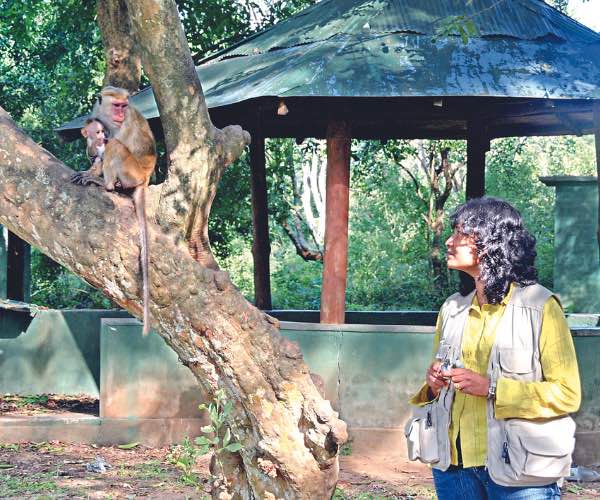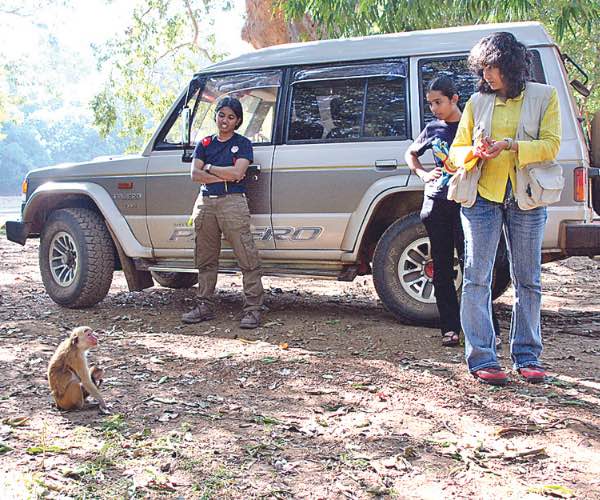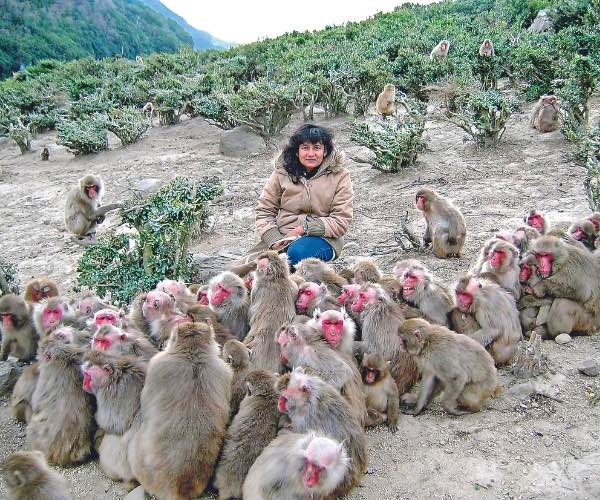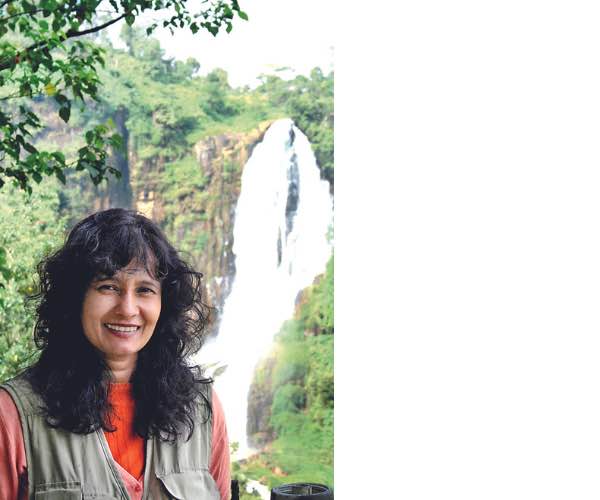
Jun 05 2024.
views 232


Prof. Charmalie Nahallage is a distinguished figure in the field of biological anthropology and a pioneering primatologist. With a career that spans over two decades, Prof. Nahallage has extensively studied the behaviour, cognition and ecology of primates. Currently serving as the head of the Department of Anthropology at the University of Sri Jayewardenepura and one of the founding members of the Primatological Society of Sri Lanka, she has made significant contributions to the understanding of primate species, particularly those endemic to Sri Lanka. In this engaging interview, Prof. Nahallage shares her journey into primatology, key research findings and her thoughts on primate-human conflict.

Q AS A PROFESSOR IN ANTHROPOLOGY, TELL US A LITTLE ABOUT YOUR AREAS OF EXPERTISE AND STUDY. My research areas are concentrated mainly in the disciplines of biological anthropology which includes primatology, forensic anthropology and research on bio-cultural aspects of different ethnic communities in the country.
Q YOUR WORK IS LARGELY BASED IN THE FIELD OF PRIMATOLOGY - WHAT INITIALLY DREW YOU TO THE FIELD OF BIOLOGICAL ANTHROPOLOGY AND MORE SO TO PRIMATOLOGY? I graduated with a Zoology Honours degree from the Faculty of Applied Sciences, University of Sri Jayewardenepura. In 1998 I was recruited to the Department of Sociology and Anthropology, as a biological anthropology lecturer because of my zoological background. This is the only department in the Sri Lankan state university system that teaches the biological anthropology component. From 1998 onwards I have been contributing to the development of biological anthropology and presently, I’m the head of the Department of Anthropology. The main subdisciplines of biological anthropology are Human morphology, Paleontology, Human ecology, Primatology and Forensic anthropology.
From the beginning, I have been interested in forensic anthropology when I did some research work with Prof. Chandrasiri Niriella at Karapitiya and then on Primatology mainly because I have been interested in studying the behaviour of animals since my childhood. In 2003, I received the Mombukagakusho scholarship to Kyoto University, Japan, where I started my Master's and Doctoral degree in primatology at the Primate Research Institute under the guidance of Prof. Michael Huffman.
Q WHAT ARE SOME KEY DISCOVERIES OR INSIGHTS YOU’VE MADE IN YOUR RESEARCH REGARDING PRIMATE BEHAVIOUR OR COGNITION? I have been studying behaviours of several primate species, including Japanese Macaques, Rhesus Macaques (Japan), Long Tailed Macaques (Bali - Indonesia), Toque Macaques and Purple-Faced Leaf Langurs etc. (Sri Lanka) throughout my career as a primatologist. They were captive, semi-free ranging and wild animals. In Japan, my studies mainly focused on how animals learn behaviours from experienced individuals and how these learned behaviours disseminate among other troop members and across generations.
Here I was able to study one of the well-researched cultural behaviours of Japanese macaques – the stone handling a solitary object play behaviour. It is a type of play behaviour in captive Japanese macaques. Through systematic long-term studies, I was able to show that even within a single troop of macaques, individuals can show variations in the same behaviour they display and there is a significant difference in the types of variations displayed according to their age, which seems to serve different functions for the young and adults.
Q SRI LANKA IS HOME TO SEVERAL UNIQUE PRIMATE SPECIES, SUCH AS THE TOQUE MACAQUE AND THE PURPLE-FACED LANGUR. WHAT MAKES THESE SPECIES DISTINCT FROM THEIR COUNTERPARTS IN OTHER REGIONS? Sri Lanka is home to five primate species with its own subspecies. The Toque Macaque/Rilawa has 3 sub species. The Toque Macaques are endemic to our country and they have the awidest distribution among the Sri Lankan primates. Though people think that Macaques can be found throughout the country, they are not the same, as there are three subspecies confined to different regions in the country. If they get extinct in their particular region they will be extinct from the whole world. This is the same for the other species of primates as well since all are endemic to Sri Lanka. Purple-Faced Leaf Langur/ kalu wandura has four subspecies. These four subspecies are confined to different regions in the country and can be seen in southern and western provinces, highland region and north central region respectively. Two Loris / unahapuluwa have Loris Tardigradus – wet zone Loris with subspecies and Loris Lydekkarianus- dry zone Loris with subspecies.
Q WHY IS IT IMPORTANT TO PROTECT THESE PRIMATES?
Q HOW HAS HUMAN ENCROACHMENT AND HABITAT LOSS IMPACTED THE POPULATIONS OF PRIMATES IN SRI LANKA? Sri Lanka is a developing country with an increase in human population and urbanization. Therefore, to provide the basic needs of humans to increase their living standards, Sri Lanka has initiated many development projects such as housing, road development, irrigation and industrial development projects. This resulted in a large-scale deforestation which is detrimental not just to primates but to all animal species. Due to the loss of natural habitats or the fragmentation of the existing forests, the primates are isolated into small forest patches that increase the competition for food and space among them and other species.
More often the animal density in these disturbed isolated forest fragments is more than the carrying capacity to maintain a healthy ecosystem and viable populations. This causes intense competition among the animals for basic resources. When the resources get depleted or scarce in the natural habitat due to competition or seasonal factors, the animals frequent the villages in search of food. Improper waste disposal sites at the edge of the villages and in temple areas further aggravate the situation.
Macaques and even Langurs visit such garbage-dumping places expecting to find food easily. Once these primates visit garbage dumping sites, it is inevitable that they will visit houses and home gardens in search of food. The utilization of human-grown crops by primates is the reason for the human-primate conflict – it’s not a new phenomenon as this has been occurring for centuries, however, at present the situation has escalated so much to the point that some people abandon farming.
However, it is important to say that not all primates cause crop damage to the same degree. The most damage was caused by the Toque Macaques. This is mainly due to their social organisation and behavioural patterns such as Omnivore feeding patterns. They prefer to live close to human habitats because they have adapted to live equally on the ground as well as on trees and live in large groups. Humans too should adjust their behaviours like dispose of garbage properly, stop feeding primates, use integrative strategies (based on behaviour, biology and habitat) to keep monkeys away from farms and make people aware of these monkeys and their behaviours.
Q HOW SHOULD PEOPLE APPROACH OUR PRIMATE COMMUNITY - WHAT’S ACCEPTABLE (FEEDING, PETTING ETC.) AND WHAT IS NOT ACCEPTABLE? Primates are wild animals, therefore people should never feed them with human-prepared food, they are capable of finding their own food so people should let these primates behave naturally without altering their habits. Once primates get used to people offering them food which is relatively easy compared to finding food in nature they get accustomed to this easy method and will steal food from people once people stop feeding them, which is a common occurrence at present in most of the tourist destinations and religious places around the country.
Further, people should never attempt to touch or pet the monkeys, especially the young animals even though they are very cute and very playful. They harbour many parasites which could be transmitted to humans through their saliva or by bites which could even cause life-threatening diseases in humans. In addition, keep your distance from them and never approach the baby primates as the adults are very protective of the young, or make them angry in any way, this will most probably end up with an attack by the monkey. Also never stare at them directly which makes them feel threatened- this could solicit an attack as well.
Q WHAT’S A DAY IN THE FIELD LIKE FOR YOU? WHAT’S THE DIFFERENCE IN STUDYING THESE SPECIES IN THE FIELD AND IN CAPTIVITY? For the last 21 years, I have been studying several species of primates in captivity, in semi-free-ranging conditions and in the wild, in Sri Lanka as well as in other countries. For me, however, it is most rewarding to spend the entire day on the field with the monkeys and observe their behaviours irrespective of the type of the field. Every day, I learn new things by being with them.
What I came to understand in my long years of field research is if you really want to study the monkeys you have to think like one. Being on the field makes you appreciate more of nature and its numerous interactions and an eye-opener to understand our role in the natural world. It makes one want to protect this unparalleled world we are living where most people don’t seem to understand its intricate relations and the silent role our environment plays in making it a safe and better place for us to live.
Q ANY PARTICULAR AREAS YOU ARE CURRENTLY RESEARCHING OR ARE INTERESTED IN RESEARCHING IN THE FUTURE? At present, I am conducting research to estimate the economic loss caused by macaques. As of now no proper or systematic estimation of economic loss caused by macaques due to crop damage was conducted. Also, there is no proper population estimation of the primates in the country, and based on the inaccurate data people are taking action to control human primate conflict which would be harmful to the primates as well. I believe we have to implement control measures using accurate data on primate populations and the economic damage they cause. Unless we do this, we will not be able to find any sustainable solution for this issue and both humans and primates will suffer as a consequence. Further, it is necessary to establish a primate research institute with proper facilities in our country as in our neighbouring countries.
Pix courtesy Prof. Charmalie Nahallage
0 Comments